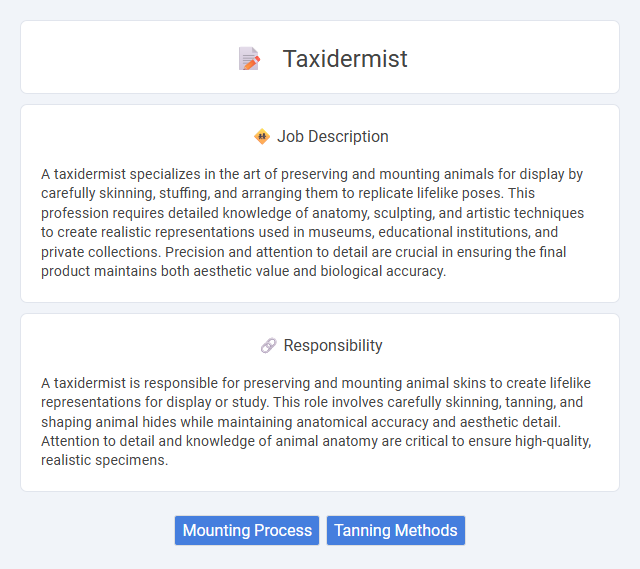
A taxidermist specializes in the art of preserving and mounting animals for display by carefully skinning, stuffing, and arranging them to replicate lifelike poses. This profession requires detailed knowledge of anatomy, sculpting, and artistic techniques to create realistic representations used in museums, educational institutions, and private collections. Precision and attention to detail are crucial in ensuring the final product maintains both aesthetic value and biological accuracy.
Individuals with strong attention to detail, patience, and an interest in biology or art are likely to be well-suited for a taxidermist job. People comfortable working with animal specimens and possessing steady hands may find this profession aligns with their skills and interests. Those with a low tolerance for handling deceased animals or a sensitivity to the sight and smell of preserved specimens might find the job challenging or unsuitable.
Qualification
Taxidermists typically require a high school diploma or equivalent, with many pursuing specialized training through vocational schools or apprenticeships to develop skills in anatomy, preservation techniques, and artistic craftsmanship. Proficiency in biology and attention to detail are essential for accurately reconstructing animal specimens for display or study. Certification from professional organizations, such as the Society of American Taxidermists, can enhance job prospects and demonstrate expertise in this specialized field.
Responsibility
A taxidermist is responsible for preserving and mounting animal skins to create lifelike representations for display or study. This role involves carefully skinning, tanning, and shaping animal hides while maintaining anatomical accuracy and aesthetic detail. Attention to detail and knowledge of animal anatomy are critical to ensure high-quality, realistic specimens.
Benefit
A taxidermist likely enjoys the benefit of applying artistic skills to preserve animals in a lifelike form, which could provide both creative satisfaction and pride in craftsmanship. Working in this field may offer steady demand from museums, educational institutions, and hunters, enhancing job stability. The profession might also provide opportunities for continuous learning about anatomy and wildlife, contributing to personal and professional growth.
Challenge
The taxidermist job likely involves intricate challenges related to preserving animal specimens in a lifelike state, requiring expert knowledge of anatomy and materials. Success may depend on the precision of mounting techniques and the ability to replicate natural poses, which can be difficult with fragile or damaged specimens. Navigating ethical concerns and legal regulations could also present ongoing difficulties in this specialized field.
Career Advancement
Taxidermists can advance their careers by specializing in high-demand areas such as wildlife conservation, museum curation, or customized trophy mounting. Gaining certifications from organizations like the American Taxidermy Association enhances professional credibility and opens opportunities for higher-paying commissions and educational roles. Developing expertise in artistic techniques and modern preservation methods positions taxidermists for leadership roles within workshops or entrepreneurial ventures.
Key Terms
Mounting Process
The mounting process in taxidermy involves carefully skinning and preserving animal hides before expertly fitting them onto custom-made molds that replicate the animal's natural anatomy. Precise attention to anatomical details ensures lifelike poses and realistic expressions by sculpting muscles and positioning eyes and ears appropriately. Specialized techniques such as tanning, fleshing, and drying enhance the durability and appearance of the mounted specimen.
Tanning Methods
Taxidermists utilize various tanning methods to preserve animal hides, including vegetable tanning, chrome tanning, and alum tanning, each offering unique benefits for durability and texture. Vegetable tanning uses natural tannins from tree bark and plant extracts, producing a firm, long-lasting leather ideal for traditional mounts. Chrome tanning employs chromium salts for a faster process, yielding soft, pliable hides resistant to water and decay, favored in modern taxidermy.
 kuljobs.com
kuljobs.com